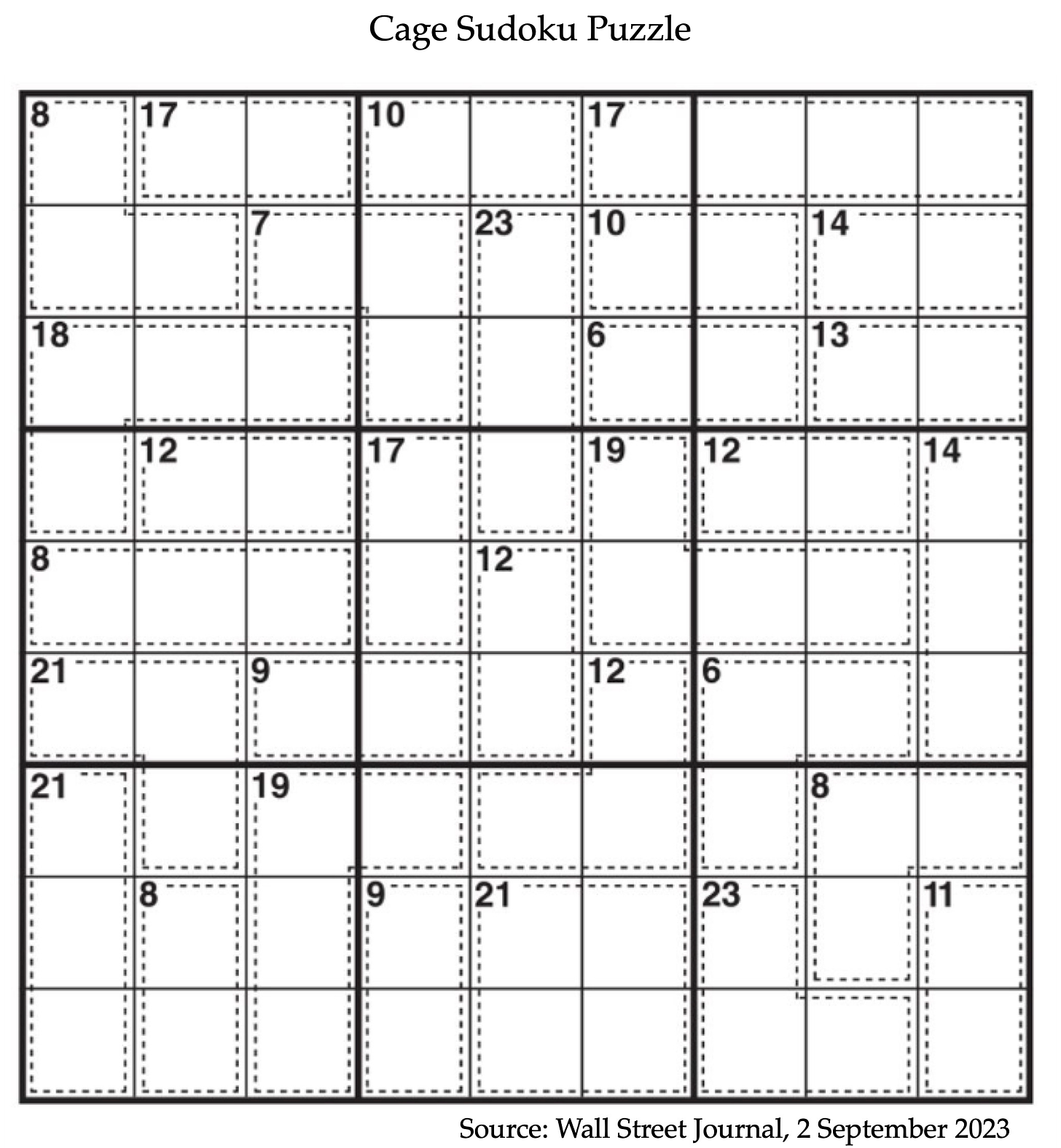Example is the school of mankind, and they will learn at no other.
Edmund Burke, Letters on a Regicide Peace, 1796
You are challenged to fill this grid with numbers so that the following rules are satisfied:
Sudoku Rule. Every column, every row, and every 3x3 block contains all the numbers 1 to 9 with no duplicate numbers.
Cage Rule. The numbers in each set of cells bounded by dotted lines sum to the number in its top left corner and the cells contain no duplicate numbers.
The Sudoku Rule defines standard sudoku that you see in newspapers, bookstores, and online. Adding the Cage Rule turns the puzzle into cage sudoku, often called killer sudoku.
Two terms add precision and facilitate discussing and thinking about a cage sudoku puzzle:
A cage is a set of cells bounded by a dotted line or defined by a distinctive background color. All cages in this essay will contain at least two cells .
Every cage carries a target, a number to which the numbers in its cells must sum. No duplicate numbers are allowed in a cage.
I saw killer sudoku puzzles every Saturday in the Wall Street Journal. They totally flummoxed me: I had no clue how to even start solving one. Eventually I told myself: I’m a mathematician, I can figure this out.
Figure it out I did. Along the way, I realized that there were concepts and methods that were central to solving the puzzles. Some methods I used routinely and others I created when the routine methods failed. But solving these puzzles was not a mechanical process. Even the routine methods required ingenuity and creativity. Fun!
My wife noticed all the work I put into these puzzles, so she suggested I lead a course at our local life-long learning institute. I prepared a proposal for "Killer Sudoku Puzzles", got it accepted, and started planning the classes. I had to turn my chaotic methods into concepts and techniques that I could explain to others. This was far more work than just solving puzzles. Indeed, the intellectual challenges were familiar: I had encountered them writing my dissertation for a Ph.D. in mathematics. There were a lot of false starts and rabbit holes. I uncovered wrong thinking, wrestled with terminology, and struggled to present ideas clearly. I was having a good time creating the theory and practice of solving these puzzles.
The first indication that the name killer sudoku was a problem arose when everyone I talked to about the course thought it was about advanced techniques for solving hard sudoku puzzles. The students in my class all thought the same. This preconception made it difficult for us to communicate about the puzzles. I had never solved a standard sudoku puzzle. My concepts and ideas all came from a direct attack on killer sudoku puzzles, so they revolved around cages. The most prominent feature of a killer sudoku puzzle is its cages while the sudoku part is not visible. Consequently, I believe the name cage sudoku is a better choice and will use it.
I conclude Part I of this series of essays with two examples that illustrate two key ideas for solving the puzzles. Refer to the puzzle at the head of this essay.
The sum of all the numbers in a block is 1 + 2 + . . . + 9 = 45. The block in the lower right corner of the grid contains three cages entirely within its boundary. These cages contain eight of the nine cells in the block. Each cage target is the sum of the numbers in its cage, so the sum of the numbers in the three cages combined is the sum of their targets. That is, the sum of the numbers in the eight cells is 23 + 8 + 11 = 42. The cell in the upper left corner that was omitted from this sum must contain the difference 45 – 42 = 3.
Look at the cage with target 23 in the middle column. The numbers in its three cells must sum to 23, but there is only one set of three different numbers in the range 1 to 9 that sums to 23 – the numbers 9, 8, and 6. The cells of the cage must contain 9, 8, and 6, but I do not know which number goes into which cell.
These examples show the fundamental difference between standard and cage sudoku. The numbers of a standard sudoku puzzle need not be numbers at all; the puzzle can be worked with any set of 9 distinct symbols, say R, S, T, U, V, W, X, Y, Z. But cage sudoku uses arithmetic so the symbols must be numbers.
Finally, the cages carry the information necessary to solve the puzzle.



